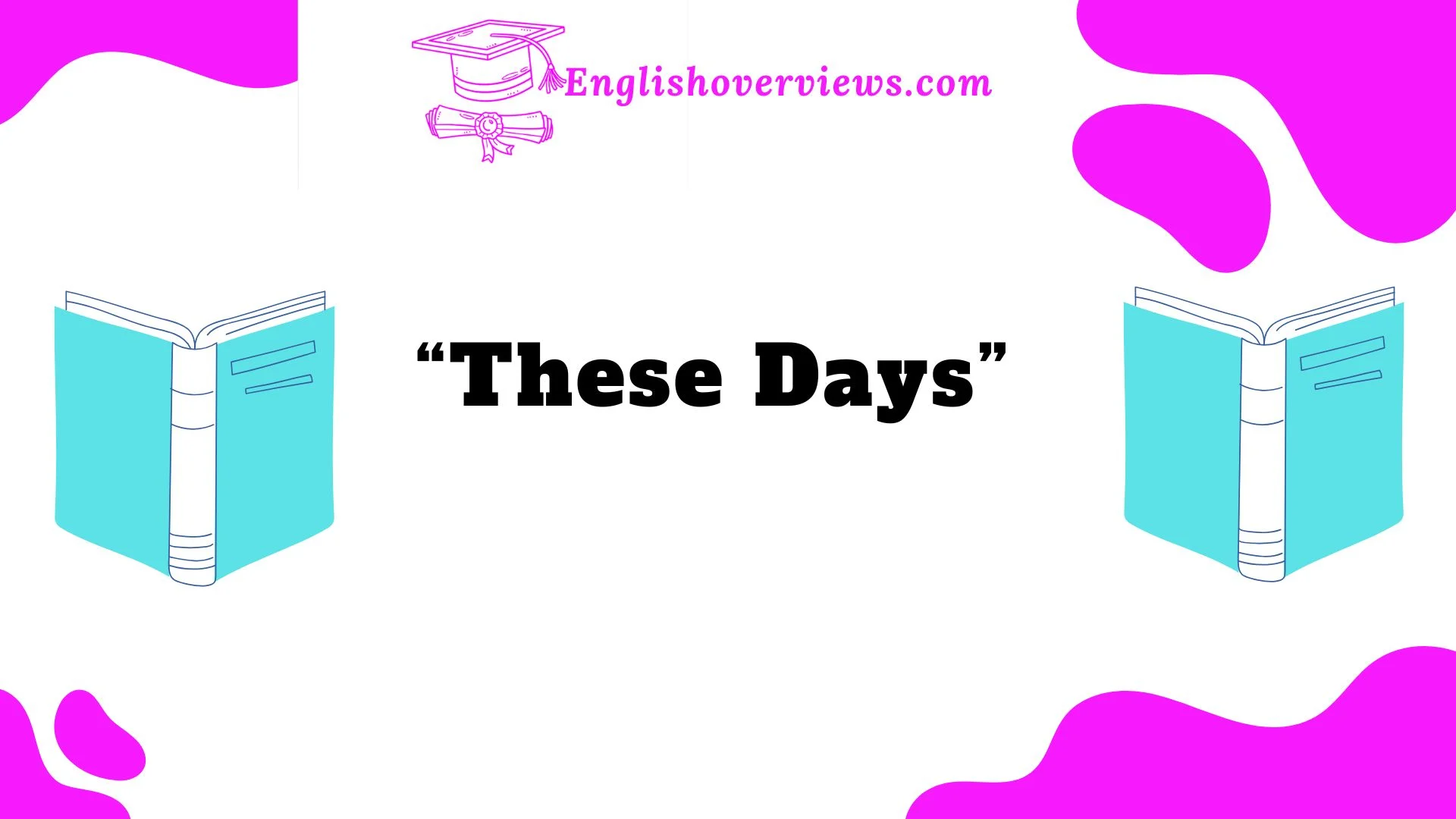Language is constantly volving, and phrases like “these days” are commonly used in spoken and written English. But is this phrase always grammatically correct? Can you use it in formal writing? How does it compare to similar expressions like “nowadays” or “recently”?
Mastering the correct usage of “these days” can improve your communication, especially if you’re a student, writer, professional, or English learner. This article provides an in-depth, easy-to-understand guide on using “these days” correctly.
By the end of this guide, you’ll learn:
✅ When to use “these days” correctly
✅ How it compares to similar phrases
✅ Grammar rules and common mistakes
✅ Formal and informal alternatives
✅ Examples of correct usage in real-world contexts
Understanding the Phrase “These Days”
The phrase “these days” refers to the present period, often in contrast with the past. It is used to describe trends, changes, and habits that are happening now.
Definition and Meaning of “These Days”
| Phrase | Meaning | Example |
|---|---|---|
| These days | Refers to the present period, usually in contrast with the past | “People rely on smartphones a lot these days.” |
| Nowadays | Similar to “these days” but slightly more formal | “Nowadays, remote work is common.” |
| Recently | Refers to a short timeframe before now | “I have been exercising a lot recently.” |
| Lately | Similar to “recently,” usually for ongoing actions | “I have been feeling tired lately.” |
Historical Evolution of “These Days”
The phrase “these days” has been in use since at least the 17th century. Over time, it has become a standard way to express current trends and changes.
📌 Example from Literature:
“The world changes so fast these days.” – Charles Dickens
Historically, older phrases like “in these times” were used instead. Today, “these days” is more natural in spoken English.
Proper Usage of “These Days” in American English
Knowing where and how to use “these days” correctly is crucial. While it is commonly spoken, there are situations where it may not be appropriate.
When to Use “These Days”
✅ To describe trends, habits, and changes over time
- “People are more conscious about health these days.”
- “Social media plays a big role in our lives these days.”
✅ To compare the present with the past
- “Kids don’t play outside as much these days as they used to.”
- “Movies these days have a lot of CGI effects.”
✅ To express ongoing or general situations
- “Finding a good job is difficult these days.”
- “Gas prices are extremely high these days.”
When NOT to Use “These Days”
🚫 For singular or specific past events
- ❌ “I met her these days.” (Incorrect)
- ✅ “I met her a few days ago.” (Correct)
🚫 In extremely formal writing
- ❌ “These days, businesses are adopting AI.” (Too casual for academic writing)
- ✅ “In recent years, businesses have increasingly adopted AI.” (More formal)
🚫 For future events
- ❌ “I will travel a lot these days.” (Incorrect)
- ✅ “I have been traveling a lot these days.” (Correct)
📌 Example:
- Incorrect: “I will visit my grandmother these days.”
- Correct: “I visited my grandmother recently.”
Case Study: Social Media Trends “These Days”
A survey by Pew Research Center found that:
- 72% of teenagers say they spend at least 3 hours daily on social media.
- Over 60% believe social media is more influential than television.
- In the early 2000s, TV was the dominant form of entertainment.
This shift in media consumption proves that social media dominates entertainment these days.
“These Days” vs. Other Time Expressions: Key Differences
Different time-related phrases may seem similar but have distinct meanings.
Comparison Table: “These Days” vs. Similar Phrases
| Phrase | Meaning | Example | Best Usage |
|---|---|---|---|
| These days | Ongoing trends compared to the past | “People read fewer physical books these days.” | Everyday speech, informal writing |
| Nowadays | More formal version of “these days” | “Nowadays, many people shop online.” | Essays, academic writing |
| Recently | A short time before now | “I started jogging recently.” | Talking about personal actions |
| At present | Formal way to describe the current time | “At present, the company is hiring new staff.” | Business, professional contexts |
📌 Example Sentence Using All Four:
“At present, remote work is the norm. These days, companies allow flexible schedules. Nowadays, employees prefer work-life balance. Recently, many have quit jobs for better opportunities.”
Key Takeaway:
- Use “these days” when comparing past vs. present.
- Use “recently” for very short-term past events.
- Use “nowadays” in formal settings.
The Grammar Behind “These Days”
Understanding the grammatical rules behind “these days” helps ensure correct usage.
Key Grammar Rules
- “These days” is always plural
❌ “This day, I go to the gym.” (Incorrect)
✅ “These days, I go to the gym.” (Correct) - It requires the present simple or present continuous tense
❌ “I am enjoying long walks these days.” (Incorrect)
✅ “I enjoy long walks these days.” (Correct)
Common Grammar Mistakes
🚫 Mixing tenses incorrectly
- ❌ “People liked reading books these days.”
- ✅ “People like reading books these days.”
🚫 Using it with past or future events
- ❌ “I will travel a lot these days.”
- ✅ “I have been traveling a lot these days.”
FAQs
❓ Is “these days” grammatically correct?
✅ Yes, but it must be used in the right context with the correct tense.
❓ Can I use “these days” in formal writing?
⚠️ It’s better to use “nowadays” or “recently” in formal contexts.
❓ What’s the difference between “these days” and “nowadays”?
📌 “Nowadays” is slightly more formal than “these days.”
Conclusion: Mastering the Use of “These Days”
Understanding and correctly using “these days” can significantly improve both your spoken and written English. This phrase is commonly used to describe current trends, compare past and present situations, and highlight ongoing changes in society.
Key Takeaways:
✔ “These days” is correct in informal and conversational English but should be used carefully in formal writing.
✔ It always refers to the present period, often in contrast with the past.
✔ It is typically used with present simple or present continuous tense to describe habits, trends, or changes.
✔ Common mistakes include using it with past or future tenses, or in very formal contexts.
✔ Alternatives like “nowadays,” “recently,” or “at present” may be more appropriate depending on the situation.
In modern English, “these days” is a valuable phrase to express changes happening in society, technology, lifestyle, and culture. Whether discussing social media trends, workplace shifts, or evolving habits, using it correctly ensures clear and natural communication.

English Overviews is a resourceful website dedicated to providing valuable content related to grammar and vocabulary.Babar Naeem has made notable contributions, sharing insights on various subjects, including WordPress themes and plugins. The primary goal of the site is to help users improve their English language skills effectively.











